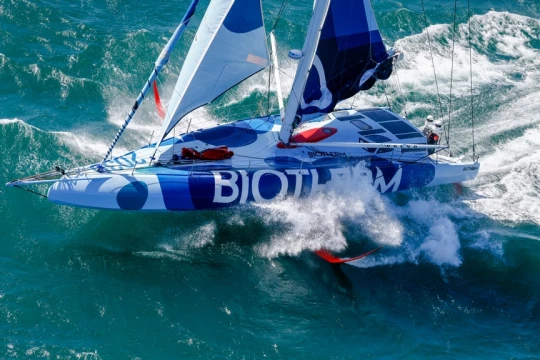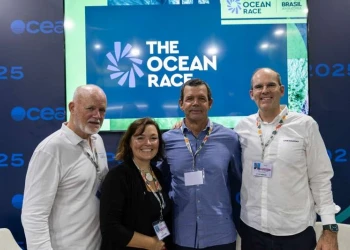
© Sailing Energy / The Ocean Race
Both Biotherm and 11th Hour Racing Team have now rejoined the race
IMOCA boats are designed to withstand the worst conditions racing across the ocean can throw at these battle-ready 60-footers. So what went wrong for Biotherm and 11th Hour Racing Team just a few minutes into this monster leg from Cape Town to Itajaí in Brazil?
Beautiful and imposing as it is, some of the sailors might be privately cursing Table Mountain. The wind shadow cast by this monster rock has played its part in previous In Port Races, and today that wind shadow turned the square race course during the leg start into two very different halves.
There was the ‘no wind’ segment, and there was the ‘too much wind’ segment. It’s not the top-end wind strength that caused the problems for the fleet, it was the sudden gusts that bulleted out of nowhere to strike the sails of the boats as they sailed downwind towards the bottom end of the race course.
At times, Team Malizia, Team Holcim-PRB and GUYOT environnement Team Europe all lurched over at 45 degrees as the gust struck their rigs. The equipment groaned under the sudden shock loads, but mostly the crews coped and the boats settled down again. However, it was one of these gusts that appeared to damage the top batten of 11th Hour Racing Team’s mainsail. The sail cloth was flogging around helplessly and over time would have shaken itself to death.

So for Charlie Enright’s crew, sailing back into the ‘no wind’ segment of the race course must have come as some relief. The American team were able to lower the mainsail to the deck to inspect the damage. It turned out to be relatively minor, as the team CEO Mark Towill explained: “The batten itself didn’t break, but it was the wing tips that hold the batten in place which broke.”
The team formally suspended racing, which under race rules meant they would have to wait a minimum two hours before they could set off again, even if the repair took considerably less time.
Enright was typically philosophical about the damage and resulting delay. “We didn’t quite make it out of Table Bay unscathed. In the last high-risk manoeuvre we didn’t get the headsail round quick enough and possibly rushed the manoeuvre a bit. We very quickly noticed that the wing tips in battens one and two had exploded. It wasn’t immediately clear whether the battens were broken or not – and as it turns out they are not.
“We actually have what we need to do the repair onboard, but that would send us into the south with no spares. It is cheaper to suspend racing now, as you can do it for a minimum of two hours, whereas after the first 12-hours of the race, there would be a mandatory 12-hour suspension.
“We will fix this properly, inspect everything, and we have a plan with the shore team who will bring out extra spares so we can sail this leg as we planned and not be compromised.
“A two hour [delay] over 35 days with all the different systems and transitions which will transpire between now and then probably won’t be the difference. I’m not saying boats won’t finish within two hours of each other, but that’s probably after the cards get shuffled a couple of times,” Enright said. The American team restarted after the mandatory two hour wait at 1507 UTC.

While 11th Hour Racing Team never felt the need to sail back to the marina at V&A Waterfront, Biotherm did return to shore. When one thing went wrong on the French boat, it dominoed into the next problem and the next after that, as British crew Sam Davies explained while she helped secure the boat back to dock.
“We broke a double strop on the mainsheet, and one of the padeyes, the rope itself blew up. The mainsheet then went out further than normal in the gybe and we blew up the end-stopper on the vang track and lost all the cars off the vang track, and we lost all the balls [ball bearings] to repair them. Repairing the mainsheet padeye is a bit of a job too, because we have to waterproof it. And then we knocked the jockey pole support off the deck. That's not too serious, though, so we should be fixed in the two hours we have to stay here anyway.”
However, that was before the team discovered that the necessary replacement parts would take slightly more time to source on shore in Cape Town on a Sunday.
Davies was adamant that returning to shore was the right decision, even if very painful after having led the fleet off the start line. “It would have been a real pain to repair at sea because we don't have enough ball-bearings to replace all of those cars, so it was a no-brainer to turn around here and get it done properly.”

Part of the problem is trying to do short-course racing on a boat that was originally designed purely for long-distance offshore racing. “We always have our foils secured on a winch,” said Davies, “which means we don’t have enough available winches to manage everything else during a tight manoeuvre.”
Skipper Paul Meilhat took the turn of events in stride: “We’re still in good spirits and motivated to get back to the race. It’s a long leg and it’s better for this to happen now rather than in the middle of the ocean. Fortunately, we decided to complete the coastal part of the start course, so we’ll be able to set sail again straightaway without having to go round all the marks again.”
Biotherm made its repairs and resumed racing at 22:20 UTC.





